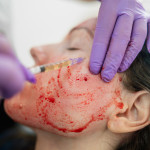Cosmetic doctors and activists say that people treated with Bio-Alcamid, a popular facial and buttock area filler for people with HIV and lipoatrophy, may end up with complications months or years after treatment. Online forums and message boards have been collecting more and more Bio-Alcamid complaints in recent years, including migration of the filler from the cheeks to the jowls and serious infections requiring heavy-duty antibiotic therapy and surgical removal of the product. At the same time, a leading cosmetic dermatologist sounding the alarm regarding Bio-Alcamid stresses that there’s no need for those who have been injected with the filler to panic.
Not yet approved in the United States—though an application has been filed—the gel-based Bio-Alcamid (polyalkylimide) was at one time a popular product used to permanently replump sunken facial and butt cheeks in people with HIV. According to Luis Casavantes, MD, a highly respected dermatologist from the Center for Cosmetic and Reconstructive Dermatology in Tijuana and Puerto Vallarta, Mexico, several thousand people spent a great deal of money to travel to other countries for treatment.
Now, some people who achieved their dream of a full and healthy-looking face after being injected with the product have instead begun to deal with what they call a nightmare—and Casavantes, who once touted the wonders of Bio-Alcamid, has publicly written to a British medical board urging it to recommend against the product’s use for people with HIV.
Casavantes is well known to many HIV-positive Americans who ventured south of the border for solutions to facial wasting. Thus, lipoatrophy treatment advocates and patients took notice when he published his letter to the National Institute for Health and Clinical Excellence (NICE) in London—which judges the cost effectiveness of treatments and has power over what treatments the United Kingdom’s National Health Service will cover. In his recent letter to NICE, he wrote: “I am at a loss for words when it comes to describing the numbers of different sorts of horrendous complications arising from the use of Bio-Alcamid and of the personal devastation wrought on the lives of these people.”
In his own practice, Casavantes estimates that as much as 15 percent of his patients who received Bio-Alcamid injections experienced complications. The Italian company Polymekon, the maker of Bio-Alcamid, claims that the actual rate of complications caused by the gel itself is less than 1 percent and that most of the reports it has seen likely involved poor administration of the product or subsequent procedures, such as dental work, that introduced bacteria into the implants. The company also claimed that the product does not migrate. Unfortunately, published data on Bio-Alcamid complications are scarce.
Even if rates of complications are as high as Casavantes believes them to be, the vast majority of people will not have problems. “You shouldn’t live in fear,” he says, adding that he never meant to alarm people with his letter. Rather, given the alternatives available today, he wants to make sure that people turn to those treatments rather than Bio-Alcamid. For people who’ve already been treated, Casavantes and advocates such as J.J. McMillen, from Houston, say that people can take precautions to guard against problems, or to catch them quickly.
What’s the Problem?
Polymekon claims that its product is ideal, because it isn’t absorbed by the body and it doesn’t provoke the body to forcibly evict its foreign matter. The company says this makes Bio-Alcamid a permanent filler, compared with several other products that are eventually broken down and removed by the immune system. But McMillen, a 47-year-old HIV-positive man who had Bio-Alcamid treatments in his face in 2004 and a subsequent infection in 2007, says that doctors have since told him that these qualities are what potentially make Bio-Alcamid dangerous.
When many fillers are injected, the body will often enclose them in layers of scar tissue (collagen) fed by blood vessels and tagged for removal from the body by the immune system. Not so with Bio-Alcamid. Thus, if bacteria make their way to the implant, McMillen says, “you don’t have the benefit of the [immune system] to deal with it.”
Polymekon might be technically correct in saying that the gel itself does not cause infections. But the implant might serve as a safe harbor for infections down the line if bacteria are somehow introduced, such as through dental procedures that occur very close to the facial areas where Bio-Alcamid is injected. We depend on our immune systems to successfully fight off these sorts of infections.
For Casavantes, this means recommending that people who want a solution for facial and buttocks wasting turn to implants that aren’t off limits to the immune system. One possible option is PMMA (polymethyl methacrylate), another permanent filler Casavantes now uses. PMMA relies on the formation of collagen and continuous blood flow, resulting in long-lasting facial filling with protection from the immune system.
Finding someone to treat infections and remove the Bio-Alcamid, McMillen says, can be frustrating and difficult. “[Doctors will] do it if they have to, but they don’t want to, and they don’t like to,” he says. “A lot of people I’ve talked to on the phone that have had infections, they can’t get anybody to work on them.”
Unfamiliarity with the product is one likely reason for this. As McMillen explains, health care providers will ask, “Why’d you put that stuff in your face?”
Casavantes says extracting Bio-Alcamid usually isn’t difficult and can be performed on an outpatient basis. Occasionally though, he says, it can be more challenging and the facial skin must be lifted off the muscle, as with a face-lift, which is a far more intensive, potentially painful and a complicated procedure.
Since people had to leave the United States to get Bio-Alcamid in the first place, and since leaving the country to deal with an infection is not usually realistic or wise, it is up to U.S. surgeons to extract the product and treat the infections. In fact, Casavantes often consults with U.S. doctors about Bio-Alcamid extraction.
An Ounce of Prevention: Disclosure and Antibiotics
Both Casavantes and McMillen urge people who’ve had Bio-Alcamid to inform all their health care providers about their implants—especially dentists, dermatologists and plastic surgeons. McMillen says: “The majority of the complications, the infections that we see with Bio-Alcamid, [are in] people who went in to have a root canal or other dental work.”
When dentists inject anesthesia into patients’ mouths, it can introduce bacteria into the Bio-Alcamid. McMillen’s HIV doctor prescribes an antibiotic for him for the day of, and the day after, any dental procedure.
McMillen says the second most common reason for problems with Bio-Alcamid involves people who’ve had touch-ups to their faces or buttocks with another filler, usually by a plastic surgeon different from the one who implanted the Bio-Alcamid. McMillen understands why people “who’ve finally gotten their faces back” would want to keep looking well, but he urges that they approach touch-ups with caution.
Larry Smyle, 61, of San Francisco fully understands the deep and painful repercussions that can come with HIV-related facial wasting. After participating in the Hawaii AIDS ride in 2001 and losing a lot of weight, he had a date with someone he’d met online. “When the guy walked in, he visibly recoiled when he saw me,” Smyle recalls, “and that’s when I decided that it was time to do something.”
Smyle says he was one of the first people with HIV to receive Bio-Alcamid implants in Mexico and, unfortunately, one of the first to experience problems. First there was dislocation: Some of the gel had migrated down into his jowls after three years, prompting him to revisit Mexico to have it removed. His doctor used a needle to do the extraction by going through the inside of his mouth, which Smyle describes as “uncomfortable, but tolerable.” Then, to add insult to injury, Smyle’s cheek became infected days later, requiring a course of heavy antibiotics.
Don’t Panic!
Casavantes reiterated that people who have received Bio-Alcamid shouldn’t panic. Most, he says, won’t have any problems. And if McMillen is right—that disclosure to other providers, caution about facial trauma and judicious use of antibiotics can help prevent problems—then most people who’ve had Bio-Alcamid treatment will probably do just fine in the long run.
Data would be useful to back up these claims. Activists might need to call for some kind of cohort, on an international level, to track what happens, over months and years, to people who’ve been treated with Bio-Alcamid, and possibly other fillers.
Though McMillen was pleased with the Bio-Alcamid treatment before the infection, he has opted to forgo further cosmetic treatment for his facial wasting. He says, “I finally had to break down and look in that mirror and see that dent in my face and say, ‘That’s all right, I’m alive, and I’m enjoying today!’”
Bio-Alcamid Blues: Possible Problems With a Facial Wasting Treatment
Bio-Alcamid, a popular treatment for facial wasting, is being scrutinized due to increasing reports of long-term complications. AIDSmeds investigates the risks for Bio-Alcamid patients.






25 Comments
25 Comments